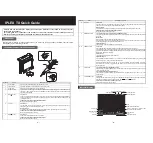
3. Functions of the Sonic System
The system is powered up auto-
matically as soon as a jack-plug is
inserted into the guitar’s end-pin
socket. The guitar and pick-up
system are now ready to use.
The overall signal output can be
controlled by the VOLUME control (1). Finger-sensitive graded
markings simplify desired adjustments. Turning clockwise raises
the volume up to an end position of 100%. Anti-clockwise motion
reduces volume.
The overall quality of the output is controlled by the second con-
trol. The TONE control (2) offers a wide variety of tone variations
by turning from one end to the other. It functions as a bass and
treble control simultaneously. Turning clockwise adds clear and
transparent highs, without cutting bass frequencies. Turning the
opposite way (anti-clockwise) adds warmth and some bass, slightly
reducing the high-end.
The nerve-centre of the Sonic System is the BLEND control (3).
This balances the signals from the two pick-ups, the magnetic
Nanomag under the fingerboard and the Nanoflex under the
bridge. In the central position both pick-ups are active. Turning
the control towards the neck increases the output of the magnetic
pick-up, while decreasing the volume of the bridge pick-up. In the
end position only the magnetic pick-up is active.
Moving the BLEND control (3) towards the bridge slowly reduces
the output of the magnetic pick-up while increasing the volume of
the Nanoflex under the bridge. In the end position the output of
the bridge pick-up is increased to 100% while the neck pick-up is
off.
The BLEND control (3) is the most important element of the
Sonic System for determining the finer points of different tones.
With the combination of a highly responsive bridge pick-up,
(putting out clearly defined, crisp and transparent highs and a
punchy sound) and a magnetic pick-up under the fingerboard
(depending on how it is played, creates a warm, almost ‘jazzy’ tone
with rich lower middle and bass) makes for a fantastic range of
sounds and colours.
The slightest adjustment of the TONE control (2) alters the
soundscape. It should be used subtly and within sensible limits so
as not to falsify the natural acoustic sound of the guitar.
Its full spectrum can of course be used to create experimental or
intentionally extreme sounds.
1. Introduction
Congratulations on the purchase of your guitar with the new
Lakewood Sonic System. The pick-up system is the result of a
collaboration between the Shadow Electronics and Lakewood
companies, to design a pick-up capable of producing a wide spec-
trum of tones and atmosphere, without the loss of the natural
sound of the guitar.
The system works with two pick-ups. First is the
Nanoflex
located
underneath the bridge and perfectly placed to transfer vibrations
from the soundboard and strings. The
Nanomag
on the other
hand, is a magnetic pick-up placed beneath the fingerboard and
invisible to the eye. The signals from both pick-ups are routed
through the Sonic Systems preamp control unit where they can be
adjusted further.
The preamp control unit is located above the soundhole, on the
inside of the guitar, scarcely visible from the outside, thus pre-
serving the look of the instrument while easily reachable for man-
ual adjustments.
Nanoflex
= bridge pickup (left above)
Nanomag
= magnetic pickup at neck position (right above)
(The displayed components are mounted invisibly)
On the underside of the control unit is a phase switch (5). This
will seldom be used but comes in handy in situations where the
guitar is only slightly amplified, for instance in a small room with
a 50% balance between pick-up sound and the natural sound of
the instrument. The phase switch (5) reverses the phase of the
vibrating strings on the guitar in line with the output signal from
the pick-up system. This switch compensates for any signal
losses.
The phase switch does not reverse the phase between the
two pick-ups (as with vintage electric guitars)!
The power for the Lakewood Sonic System is provided by two 3-
volt Lithium batteries. These tiny batteries are located in a battery
holder (6) on the control unit. A battery display (4) shows battery
status. Normally the light is switched off. When battery power is
low it lights up and batteries should be replaced immediately. To
open the battery holder, push the left and right clips gently to-
gether and remove the battery container. When exchanging bat-
teries, the plus side of the battery must face upwards (towards
the top). Replace the battery container. An audible click is heard
when it finds its correct position.
4. Suggested settings for different styles
Strumming :
Blend control (3) in the central position. Tone
control (2) in central position.
Fingerpicking :
Blend control (3) 75% from bridge pick-up and
25% from the magnetic pick-up. Tone control (2) slightly to-
wards the treble end (clockwise from the centre).
Jazz :
Blend control (3) 90% from the magnetic pick-up and
10% from the bridge Pick-up. Tone control (2) turned ¾ to-
wards the bass end (anti-clockwise).
SONIC
SYSTEM
VOLUME
TONE
BLEND
PHASE
NANOFLEX
NANOMAG
2. Directions for using the Sonic System Preamp Control Unit
1 2
3
4
5
6
In
– a
nd
ou
tp
ut
f
or
picku
p c
abl
es
an
d
jac
k-
plug




















